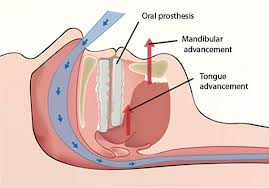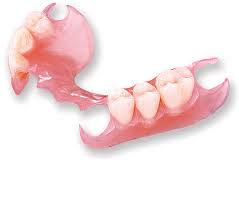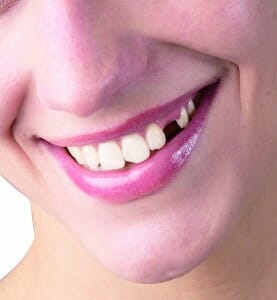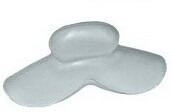A mouthpiece can be an excellent solution when it comes to preventing snoring. However, if you’ve had dental work performed such as dentures (full or partial) bridge work, or crowns (caps), you may have a number of questions related to your ability to use a mandibular advancement device. Several manufacturers fail to address this concern, leaving potential customers in the dark. The following information should help clear up some of the confusion surrounding such devices.
The mechanics of the mandibular advancement device
 Before discussing whether or not a mouthpiece is a good fit, it’s important to first understand exactly how most mouthpieces work. Whether you are interested in the Zquiet, Vitalsleep, Snoremender, or any other mandibular advancement device, they all work by using the same principle – advancing the jaw by pushing out on lower six front teeth while applying inward pressure on the upper front teeth. Keep in mind that this does not necessarily mean that all MAD’s are created equal as some are more comfortable to wear and better built than others.
Before discussing whether or not a mouthpiece is a good fit, it’s important to first understand exactly how most mouthpieces work. Whether you are interested in the Zquiet, Vitalsleep, Snoremender, or any other mandibular advancement device, they all work by using the same principle – advancing the jaw by pushing out on lower six front teeth while applying inward pressure on the upper front teeth. Keep in mind that this does not necessarily mean that all MAD’s are created equal as some are more comfortable to wear and better built than others.
Since this type of mouthpiece relies on the presence of strong upper and lower front teeth, many manufacturers recommend that you do not use such a device if you have loose or missing teeth, particularly in the front. What about those who wear dentures or have bridges or caps? Is it possible to use a standard mandibular advancement device to prevent snoring?
Using a mouthpiece with full or partial dentures
 One of the most common questions often asked by snorers is whether or not one with full or partial dentures can use a MAD. Most mouthpiece manufactures recommend against using a MAD if you wear full dentures. Those who wear partials may have the ability to use such a device. Remember, strong upper and lower front teeth are a necessity. Generally speaking, if your partials are in the front portion of your upper or lower teeth then you are likely not a good candidate for a mouthpiece. The best practice is to show your dentist the device that you are interested in and ask if it would be a good fit considering your partials.
One of the most common questions often asked by snorers is whether or not one with full or partial dentures can use a MAD. Most mouthpiece manufactures recommend against using a MAD if you wear full dentures. Those who wear partials may have the ability to use such a device. Remember, strong upper and lower front teeth are a necessity. Generally speaking, if your partials are in the front portion of your upper or lower teeth then you are likely not a good candidate for a mouthpiece. The best practice is to show your dentist the device that you are interested in and ask if it would be a good fit considering your partials.
Bridges, crowns, and missing teeth
 Perhaps you have bridge or crown work and would like to know whether or not a mouthpiece is a good idea. As with partial dentures, the answer greatly depends on the position of your bridge(s) or crown(s) and the overall health of your remaining natural teeth. Those who have bridges or crowns located at the rear of the gums would certainly be a better candidate than those who’ve had work done on the front teeth. Strong, healthy teeth at the front of the mouth are a requirement which should not be overlooked.
Perhaps you have bridge or crown work and would like to know whether or not a mouthpiece is a good idea. As with partial dentures, the answer greatly depends on the position of your bridge(s) or crown(s) and the overall health of your remaining natural teeth. Those who have bridges or crowns located at the rear of the gums would certainly be a better candidate than those who’ve had work done on the front teeth. Strong, healthy teeth at the front of the mouth are a requirement which should not be overlooked.
If you have missing teeth this may present another challenge when it comes to wearing an anti-snoring device. Once again, you should consider the location of the missing teeth and the overall health of the surrounding teeth. As always, consult with your dentist if you have questions related to your particular situation.
Is there an alternative anti-snoring device for those who can’t use a MAD?

The “Good Morning Snore Solution” can be a great substitute for a mandibular advancement device
So you have concluded that a traditional snoring mouthpiece may not be a good decision. Perhaps your oral health is not up to par or dental work such as dentures, crowns or bridges are preventing you from moving forward with this decision. Are there any other solutions out there that may work for you? Fortunately, there is a product out there called the Good Morning Snore Solution which works using a completely different principle. The GMSS is considered a “Tongue Stabilizing Device” (TSD) and controls snoring by holding the tongue forward in lieu of the lower jaw. Since this particular device rests on the outside of the lips and does not require the use of teeth as leverage points, the manufacturer suggests that it can be used by denture wearers. The same could also be true for those who have had other dental work such as bridges, caps, or even missing teeth.
Does this TSD work? How effective is it in comparison traditional MAD devices?
I have experimented with the GMSS and can tell you firsthand that it works quite well. The device attaches to the tip of your tongue using a suction bulb that resembles a pacifier and rests on the outside of your lips. The sensation is odd at first but you will eventually become accustomed to wearing one. I’ve had great success with the GMSS and would recommend it as an alternative to the typical MAD. As for overall effectiveness, several studies have been conducted comparing the MAD to the TSD. The results indicated that a TSD such as the GMSS is often just as effective at controlling snoring as a MAD.
A word of caution
As always, it is advisable that you consult with your physician or dentist before deciding to treat a snoring issue. This is especially true if you have any of the above-mentioned conditions. Evaluation of the potential use of a MAD should be completed on a case-by-case basis by a qualified medical professional. Everyone’s situation is unique and this should be taken into consideration before moving forward with any treatment.
Which mouthpiece should I buy?
The anti-snoring mouthpiece is one of the most highly effective stop snoring solutions available. With over 100 different products to choose from, deciding which one to buy can be challenging.
As a snorer and product reviewer, I have tried many of these devices and created a list of recommended devices that will help to make this decision much easier.
Share This Post: